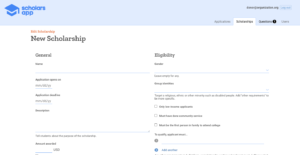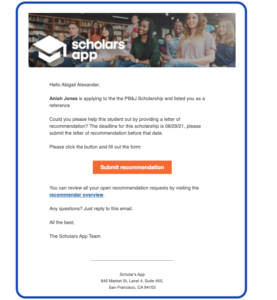For the average American family with high school-age kids, paying for college has slowly grown from a lingering worry in the back of their minds to a full-blown cause for panic. And it’s easy to understand why.
The average cost of college for just one child to attend for a single year is about $35,720, which is nearly half the average annual income for a two-person home in 2020 ($67,521), according to the United States Census Bureau.
As a result, many students rely on financial aid, student loans, and scholarships, besides any parental support they may have, to fund their educational pursuits.
Related: The Positive Impact of Digital Scholarships on American Education
However, given that only 1 in 8 students is likely to receive a scholarship and that the average award is $7,923, it’s actually miraculous that the average student loan debt is so low.
If you factor in additional children, reduced spending power because of the ongoing pandemic, and increased inflation, it is only a matter of time before college enrollment sees the negative impact of the ballooning costs of tertiary education.
The State of Scholarships in the USA
According to the National Center for Education Statistics, 19,813,000 students are projected to enroll in college in 2022. Of those who are college-bound, 4 out of 10 rate cost as the most important factor in choosing where to study. Nearly 49% of their parents expect scholarships and grants to play a role in financing their children’s education. In reality, only about a third of recent graduates claim to have benefitted from such free financing.
At first glance, it would appear scholarships and grants are abundantly available for all who qualify. But a deeper look reveals a gap between what is needed, what is available, and those who benefit. The largest federal scholarship is the Pell Grant, a need-based scholarship available to students who show exceptional financial need on the FAFSA. The 2020 interaction of the How America Pays for College report found that
- 43% of families did not submit the FAFSA because they did not believe they would qualify
- 16% missed the deadline
- 15% had issues with the application
- 14% knew nothing about the FAFSA
- 11% did not have the necessary information to complete the application
- and 5% did not have time to submit.
The report indicates an overall lack of awareness and accessibility to the right scholarship-related resources.
Besides the fact that scholarship funds are limited, they are also not getting around to the underprivileged students who need them. Of the recipients of these various scholarships, students from middle-income families received 13.8% of the scholarships, while students from low-income backgrounds received 10.6%.
How is a Digital Scholarship Fund Different from a Traditional Scholarship Program?
It’s no secret that digitalization has made things easier and faster for many industries. Educational scholarships have also benefited from the positive impact of going digital, both from the perspective of donors and that of applicants.
From the point of view of individual donors and scholarship funds, digitalization has made investing in online scholarships easier to do. With as little as $5000, individual donors can set up a scholarship fund, review applications, and award to selected recipients with minimal administrative work and additional finance. A digital scholarship fund provides seamless monitoring capabilities and accurate applicant analytics faster than a traditional scholarship, which typically requires significantly more resources.
Even for the applicants, an online scholarship is more accessible. As students complete their applications, they get instant feedback on the format, ensuring all necessary documents are uploaded on time for review. All of this helps to reduce the time between the scholarship deadline and award to selected recipients.
Related: Getting More Qualified Applicants for Your Digital Scholarships
How Easy is it to Become a Digital Scholarship?
With the right scholarship management platform, setting up a digital scholarship fund becomes simple and straightforward. All you need to do is decide who you want to help (eligibility requirements), the amount of the award, and the timeframe. The scholarship management platform acts similar to a managed service, doing all the other heavy lifting from monitoring to marketing and more.
If you’d like to learn more, we created a comprehensive checklist on how to launch a fully digital scholarship fund. In essence, there are 5 steps you need to consider:
- Decide on the award amount
- Understand state laws and regulations
- Determine the eligibility criteria
- Duration of fund
- Promoting your scholarship fund
What to Look for in a Scholarship Management Platform?
Although starting a digital scholarship fund is much easier than a traditional scholarship, it can still become quite time-consuming for the average donor who simply desires to help students fund their higher education. Using a scholarship management platform frees donors from the administrative work and speeds up the process so underprivileged students get the funding they require promptly.
When selecting a scholarship management platform, look for one with the following qualities:
- Advisory Role: The platform you choose must have an active customer support team and experts that can help you navigate scholarship fund requirements including award amount, deadlines, eligibility criteria, and so on
- Marketing: A platform with an extensive scholarship directory and resources for a large user base consisting of students, parents, and counselors will also help significantly.
- Selection & Disbursement: Your scholarship partner should also help with reviewing and processing applications, confirming eligibility, collaboration amongst reviewers, assisting with tracking and disbursing funds, etc.
- Administration: One of the main goals of using scholarship management software is to reduce administrative overhead so look for a platform that provides feedback to applicants, monitors, and provides accurate reports on the application process.
- Easily Accessible: Avoid software that has a significant upfront cost or a form of vendor lock. The ideal scholarship management software should be easily accessible through most web browsers.
How Scholar’s App Helps Donors and Scholarship Funds
Scholar’s App is an all-in-one platform for providing and managing scholarships. Scholarship funds and individual donors using Scholar’s App receive 2x the amount of qualified and completed applications than they did before, at much lower costs, thanks to an intuitive user interface that makes it easier for students to find the right scholarship.
Post ListingEasily post your scholarship listing, and let Scholar’s App create a customized application form. Using the specified criteria, we only display your listing to qualified candidates who can then apply online. |
 |
 |
Reach StudentsScholar’s App markets to tens of thousands of students and counselors, who are verified before they can join our network. We handle both digital and traditional marketing campaigns for your scholarship. |
Qualified ApplicationsScholar’s App uses a comprehensive system to match scholarships with qualified students. We also ensure applications are submitted with essays, transcripts, letters of recommendation, and any other documents that may be part of your particular application process. Collaborate with your review committee onlineScholar’s App offers a central dashboard where donors and reviewers can conduct the scoring process together |
 |




